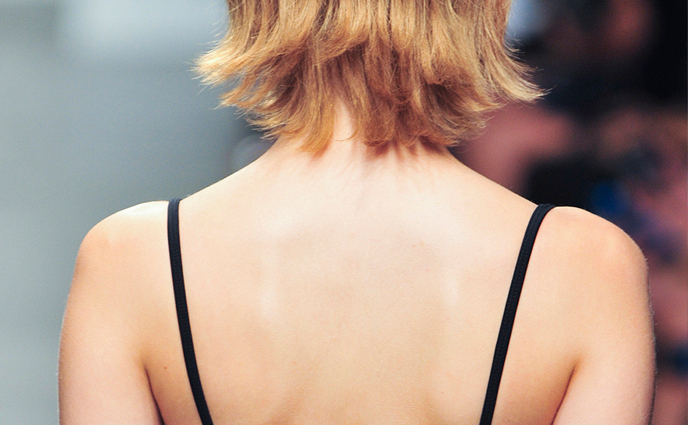Like birth control pills, antibiotics can be taken for several months to treat acne. Your derm will probably prescribe a "-mycin" or a "-cycline" -- that is, erythromycin, clindamycin, tetracycline, minocycline or doxycycline. They're usually prescribed in combination with topical antibiotics to clear bacteria and reduce inflammation.
Another interesting med option: spironolactone, a blood-pressure medication that's used off-label for relieving acne. Spiro is an anti-androgen, and because oil production is an androgen function, it decreases the amount of sebum in the skin, thwarting pimples.
Your Rx: Talk to your derm about whether your acne is hormonal, which can help lead you to the right prescription. "Oral antibiotics work well for people with inflammatory acne and cysts," says Tanzi. "Spironolactone works better for women with adult-onset acne that has a strong hormone component."
Another interesting med option: spironolactone, a blood-pressure medication that's used off-label for relieving acne. Spiro is an anti-androgen, and because oil production is an androgen function, it decreases the amount of sebum in the skin, thwarting pimples.
Your Rx: Talk to your derm about whether your acne is hormonal, which can help lead you to the right prescription. "Oral antibiotics work well for people with inflammatory acne and cysts," says Tanzi. "Spironolactone works better for women with adult-onset acne that has a strong hormone component."
You've probably heard that there are no quick fixes when it comes to acne. Except there are. If you end up with a honker of a pimple, ask your derm for a quick prick.
"Cortisone appears naturally in the body in response to inflammation," says Peredo. "Injecting it directly into a cystic acne lesion works to quickly reduce swelling and speed up the healing process." While this doesn't remove the bacteria that causes the nodule in the first place, cortisone helps reduce the pimple's size within 24 hours.
Your Rx: Cortisone injections aren't practical for regular use, but they're a good option in emergency social situations. "Cortisone shots are great for if you have an upcoming big event like a wedding," says Peredo.
"Cortisone appears naturally in the body in response to inflammation," says Peredo. "Injecting it directly into a cystic acne lesion works to quickly reduce swelling and speed up the healing process." While this doesn't remove the bacteria that causes the nodule in the first place, cortisone helps reduce the pimple's size within 24 hours.
Your Rx: Cortisone injections aren't practical for regular use, but they're a good option in emergency social situations. "Cortisone shots are great for if you have an upcoming big event like a wedding," says Peredo.
Women who suffer from adult acne find themselves at that uncomfortable intersection of pimples and wrinkles: Which do you treat? Both, as it turns out, with a retinoid prescription.
"Retinoids work by irritating the skin, which in turn is good because this [causes] exfoliation," says Goldfaden. "They can help clear mild acne by normalizing how skin cells grow and then shed."
Tanzi recommends prescription retinoids over the OTC variety, which don't contain a high enough concentration of retinoic acid to be effective against acne.
Your Rx: Talk to your doctor about trying a retinol prescription; brand-name meds include Retin-A, Tazorac and Differin.
"Retinoids work by irritating the skin, which in turn is good because this [causes] exfoliation," says Goldfaden. "They can help clear mild acne by normalizing how skin cells grow and then shed."
Tanzi recommends prescription retinoids over the OTC variety, which don't contain a high enough concentration of retinoic acid to be effective against acne.
Your Rx: Talk to your doctor about trying a retinol prescription; brand-name meds include Retin-A, Tazorac and Differin.
If there's anything worse than a pimple, it's the scar that it leaves behind. Scars -- more precisely, post-inflammatory hyperpigmentation -- occur when the pimple's inflammation stimulates your skin's melanocytes to produce melanin, which is the pigment in your skin.
"There are three imperative steps" to treat hyperpigmentation, says Goldfaden. "Exfoliate, treat with a lightening agent and protect with [sunscreen]."
Your Rx: Tanzi treats hyperpigmentation with "short bursts" of hydroquinone and mushroom-derived kojic acid, which lighten skin by curbing melanin production. (GloTherapeutics Lightening Serum contains both ingredients.) Goldfaden recommends his Goldfaden MD Light Treatment Dark Spot Corrector, which uses arbutin, "a natural ingredient derived from berries that inhibit[s] melanin production and breaks down whatever darkness is already on the surface."
"There are three imperative steps" to treat hyperpigmentation, says Goldfaden. "Exfoliate, treat with a lightening agent and protect with [sunscreen]."
Your Rx: Tanzi treats hyperpigmentation with "short bursts" of hydroquinone and mushroom-derived kojic acid, which lighten skin by curbing melanin production. (GloTherapeutics Lightening Serum contains both ingredients.) Goldfaden recommends his Goldfaden MD Light Treatment Dark Spot Corrector, which uses arbutin, "a natural ingredient derived from berries that inhibit[s] melanin production and breaks down whatever darkness is already on the surface."
Pimples are always a PIA, but they're not all alike. The blanket term "acne" or "pimple" really applies to a range of skin imperfections.
Your acne is considered mild if you have comedones, aka blackheads and whiteheads. Blackheads are blemishes that aren't under the skin and look like tiny, dark-colored spots. Whiteheads are closed blemishes that appear as small bumps in the skin.
Papules, a sign of moderate acne, are slightly larger bumps that occur when bacteria infects the hair follicle. They may become filled with pus.
Hard, swollen bumps that are painful to the touch are known as nodules, and these are a sign that your acne is severe. Cysts are like nodules -- large, painful bumps -- that are filled with pus.
Your Rx: If you have comedones, that's a sign that drugstore products with benzoyl peroxide or salicylic acid will clear them. If you have papules or nodules, you might need a dermatologist's help.
Your acne is considered mild if you have comedones, aka blackheads and whiteheads. Blackheads are blemishes that aren't under the skin and look like tiny, dark-colored spots. Whiteheads are closed blemishes that appear as small bumps in the skin.
Papules, a sign of moderate acne, are slightly larger bumps that occur when bacteria infects the hair follicle. They may become filled with pus.
Hard, swollen bumps that are painful to the touch are known as nodules, and these are a sign that your acne is severe. Cysts are like nodules -- large, painful bumps -- that are filled with pus.
Your Rx: If you have comedones, that's a sign that drugstore products with benzoyl peroxide or salicylic acid will clear them. If you have papules or nodules, you might need a dermatologist's help.
What causes acne, how to prevent acne from forming, and how to treat existing acne are three of the most mystifying issues in dermatology today. That's because acne can be influenced by such a weird amalgamation of factors -- from major influences like lifestyle, heredity and stress down to seemingly insignificant details like what you pour over your cereal in the morning. Here's everything we know about acne and how to cure it, from the foods that cause acne to pimple home remedies to antibiotics for acne.




